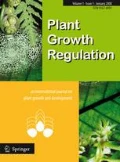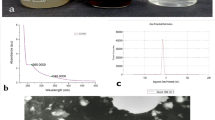Abstract
Selenium (Se), one of the most widely distributed elements of the earth’s crust, is required in trace amounts for normal growth and development of biological activity but its increasing level in soil poses productivity problems in many crops including sugarcane. In the present investigation, a promising line of sugarcane (CoLk 94184) was used to assess the impact of selenium on growth, physio-biochemical attributes vis-à-vis expression of metallothionein (MT) gene. Single bud setts of sugarcane (Saccharum spp. hybrids) was planted with differential levels of selenium (sodium selenite) viz., 0, 10, 50 and 100 ppm under soil tray culture conditions. At higher concentrations (50 and 100 ppm Se), symptoms of metal toxicity as stunted growth, reduced plant height, vigor, root, shoot weight and leaf chlorosis were observed. Biochemical analysis revealed reduction in content of chlorophylls, carotenoids, proline and induction of lipid peroxidation in terms of malondialdehyde content and higher activity of peroxidase enzyme. qRT-PCR analysis indicated increase in expression of MT gene in leaf tissue with an increase in Se supply and highest expression was observed at 50 ppm Se. At 100 ppm supply, adverse effect of Se was very severe and a minor increase in expression of MT gene was observed. Results suggest that MT gene is related to the Se homeostasis which in turn helps in tolerance to Se toxicity in sugarcane.




Similar content being viewed by others
Abbreviations
- MT:
-
Metallothionein
- MDA:
-
Malondialdehyde
- mRNA:
-
Messenger ribonucleic acid
- TCA:
-
Trichloroacetic acid
- TBA:
-
Thiobarbutaric acid
- DAP:
-
Days after planting
References
Arnon DI (1949) Copper enzymes in isolated chloroplasts: polyphenol oxidase in Beta vulgaris. Plant Physiol 24:1–15
Bates LS, Waldren RP, Teare ID (1973) Rapid determination of free proline for water-stress studies. Plant Soil 39:205–207
Bradshaw AD, McNeilly T, Putwain PD (1990) The essential qualities. In: Shaw AJ (ed) Heavy metal tolerance in plants: evolutionary aspects. CRC Press, Boca Raton, pp 323–334
Broadley MR, White PJ, Hammond JP, Zelko I, Lux A (2007) Zinc in plants. New Phytol 173:677–702
Cenkci S, Ciererch IH, Yildiz M, Ozay C, Bozdag A, Terzi H (2010) Lead contamination reduces chlorophyll biosynthesis and genome template stability in Brassica rapa L. Environ Exp Bot 67:467–473
Cochran WG, Cox GM (1957) Experimental designs. Wiley, New York
Ellis DR, Salt DE (2003) Plants, selenium and human health. Curr Opin Plant Biol 6:273–279
Germ M, Stibilj V, Kreft I (2007) Metabolic importance of selenium for plants. Euro J Plant Sci Biotechnol 1:91–97
Guo J, Xu L, Su Y, Wang H, Gao S, Xu J, Que Y (2013) ScMT 2-1-3, a metallothionein gene of sugarcane, plays an important role in the regulation of heavy metal tolerance/accumulation. BioMed Res Inter. doi:10.1155/2013/904769
Gupta DK, Nicoloso FT, Schetinger MRC, Rossato LV, Pereira LB, Castro GY, Srivastava S, Tripathi RD (2009) Antioxidant defence mechanism in hydroponically grown Zea mays seedlings under moderate lead stress. J Hazard Mater 172(1):479–484
Hamer DH (1986) Metallothionein. Annu Rev Biochem 55:913–951
Hamilton SJ (2004) Review of selenium toxicity in the aquatic food chain. Sci Total Environ 326:1–31
Hartikainen H, Xue T (1999) The promotive effect of selenium on plant growth as trigged by ultraviolet irradiation. J Environ Qual 28:1272–1275
Hartikainen H, Xue T, Piironen V (2000) Selenium as an antioxidant and pro-oxidant in ryegrass. Plant Soil 225:193–200
Heath RL, Packer L (1968) Photoperoxidation in isolated chloroplasts. Arch Biochem Biophys 125:189–198
Hossain MA, Piyatida P, da Silva JAT, Fujita M (2012) Molecular mechanism of heavy metal toxicity and tolerance in plants: central role of glutathione in detoxification of reactive oxygen species and methylglyoxal and in heavy metal chelation. J Bot. doi:10.1155/2012/872875
Jain R, Srivastava Sangeeta, Madan VK (2000) Influence of chromium on growth and cell division of sugarcane. Indian J Plant Physiol 3:228–231
Jain R, Shrivastava AK, Srivastava S (2004) Heavy metals in industrial wastes and their effect on sugarcane. Inter Sugar J 22:23–27
Kavi Kishor PB, Hong Z, Miao GH, Hu CA, Verma DPS (1995) Overexpression of Δ1-pyrroline-5-carboxilate synthase increases proline production and confers osmotolerance in transgenic plants. Plant Physiol 108:1387–1394
Küpper H, Küpper F, Spiller M (1996) Environmental relevance of heavy metal-substituted chlorophylls using the example of water plants. J Exp Bot 47:259–266
Lowry OH, Rosenbrough NJ, Farr AL, Randall RJ (1951) Protein measurement with the Folin phenol reagent. J Biol Chem 193:265–375
Luck H (1963) Peroxidase. In: Bergmeyer HU (ed) Methods in enzymatic analysis. Academic Press, New York, pp 895–897
Mehta SK, Gaur JP (1999) Heavy-metal-induced proline accumulation and its role in ameliorating metal toxicity in Chlorella vulgaris. New Phytol 143:253–259
Oláh V, Lakatos G, Bertok C, Kanalas P, Szollosiz E, Kis J, Meszaros I (2010) Short-term chromium (VI) stress induces different photosynthetic responses in two duckweed species, Lemna gibba L. and Lemna minor L. Photosynthetica 48:513–520
Oncel I, Keles Y, Ustun AS (2000) Interactive effects of temperature and heavy metal stress on the growth and some biochemical compounds in wheat seedlings. Environ Pollut 107:315–320
Pandey N, Sharma CP (2003) Chromium interference in iron nutrition and water relations of cabbage. Environ Exp Bot 49:195–200
Pourraut B, Shahid M, Dumat C, Winterton P, Pinelli E (2011) Lead uptake, toxicity and detoxification in plants. Rev Environ Contam Toxicol 213:113–136
Prasad DPH, Prasad ARK (1987) Effects of lead and mercury on chlorophyll synthesis in mungbean seedlings. Phytochemistry 26:881–884
Rotruck JT, Pope AL, Ganther HE, Hoekstra WG (1973) Selenium: biochemical role as a component of glutathione peroxidase. Science 179:588–590
Shamberger RJ (1981) Selenium in the environment. Sci Total Environ 17:59–74
Shanker AK (2006) Countering UV-B stress in plants: does selenium have a role? Plant Soil 282:21–26
Teixeira J, Ferraz P, Almeida A, Verde N, Fidalgo F (2013) Metallothionein multigene family expression is differentially affected by chromium (III) and (VI) in Solanum nigrum L. plants. Food Energy Secur 2:130–140
Terry N, Zayed AM, de Souza MP, Tarun AS (2000) Selenium in higher plants. Annu Rev Plant Physiol Plant Mol Biol 51:401–432
Tinggi U (2003) Essentiality and toxicity of selenium and its status in Australia: a review. Toxicol Lett 137:103–110
Wu XP, Liang D, Bao J, Xue R (2009) Effects of different concentrations of selenate and selenite on growth and physiology of Chinese cabbage. Acta Scientiae Circumstantiae 29:2163–2171
Xue T, Hartikainen H, Piironen V (2001) Antioxidative and growth-promoting effect of selenium in senescing lettuce. Plant Soil 237:55–61
Yadav DV, Jain R, Rai RK (2010) Impact of heavy metals on sugar cane. In: Sherameti I, Verma A (eds) Soil heavy metals: soil biology series, vol 19. Springer, Berlin, pp 339–367
Zhou G, Xu Y, Li J, Yang L, Liu JY (2006) Molecular analyses of the metallothionein gene family in rice (Oryza sativa L.). J Biochem Mol Biol 39:595–606
Acknowledgments
We would like to thank Director, Indian Institute of Sugarcane Research (ICAR Unit), Lucknow for his encouragement and support. We are also thankful to Dr. Mani Ram Verma (Chief Technical Officer) for statistical analysis.
Author information
Authors and Affiliations
Corresponding author
Rights and permissions
About this article
Cite this article
Jain, R., Verma, R., Singh, A. et al. Influence of selenium on metallothionein gene expression and physiological characteristics of sugarcane plants. Plant Growth Regul 77, 109–115 (2015). https://doi.org/10.1007/s10725-015-0042-1
Received:
Accepted:
Published:
Issue Date:
DOI: https://doi.org/10.1007/s10725-015-0042-1




